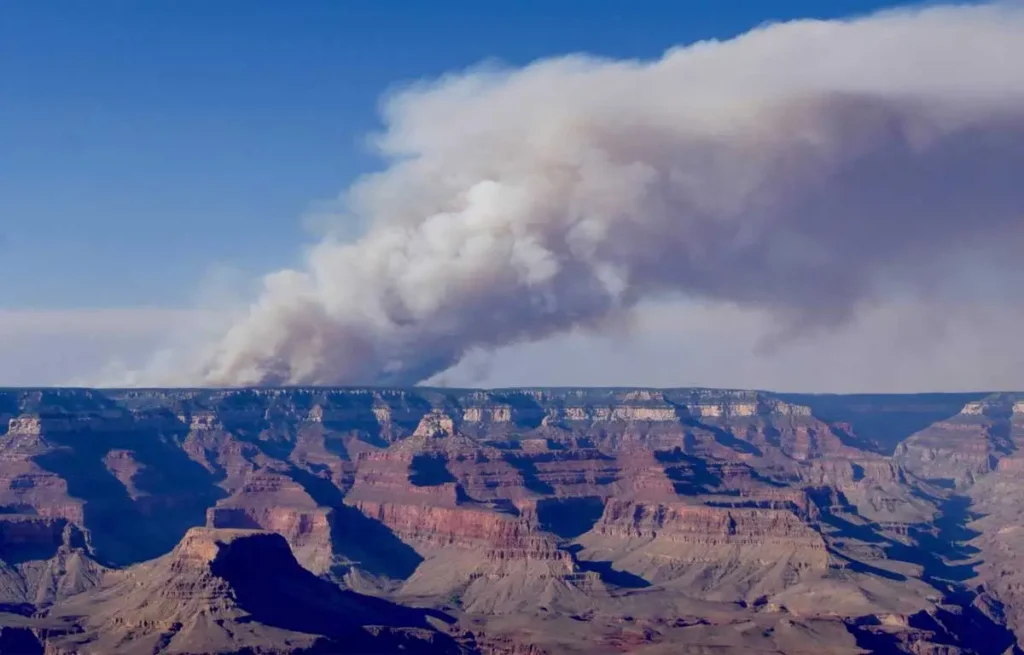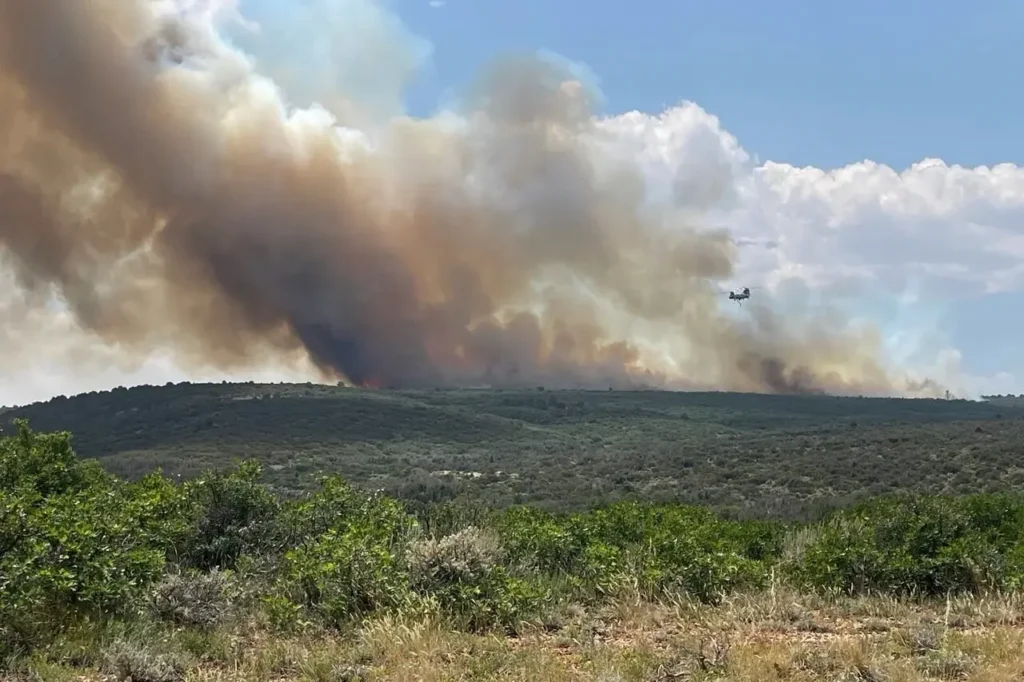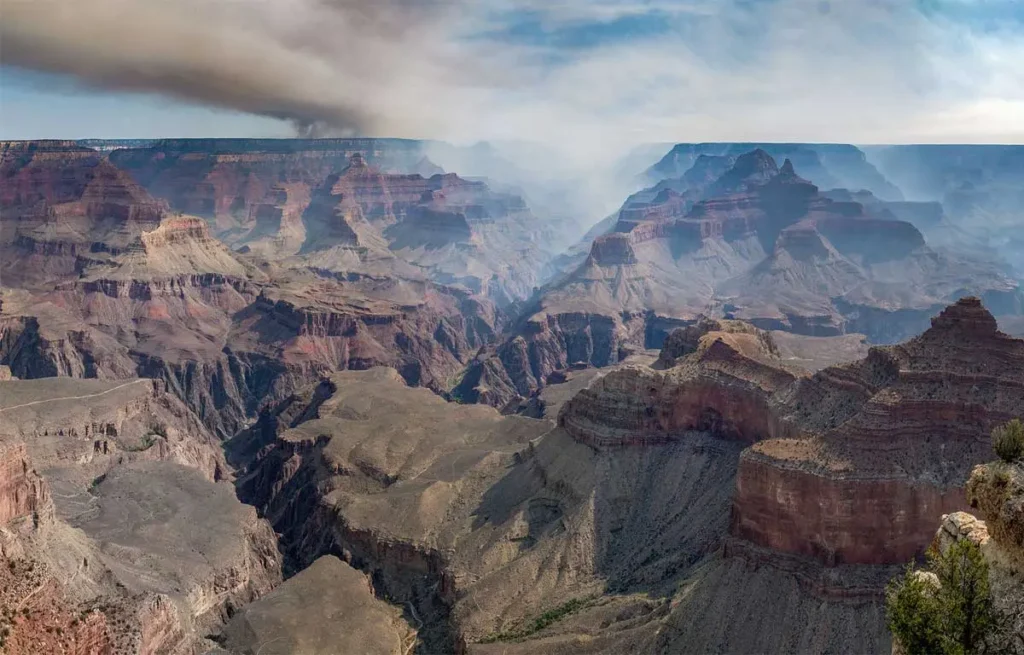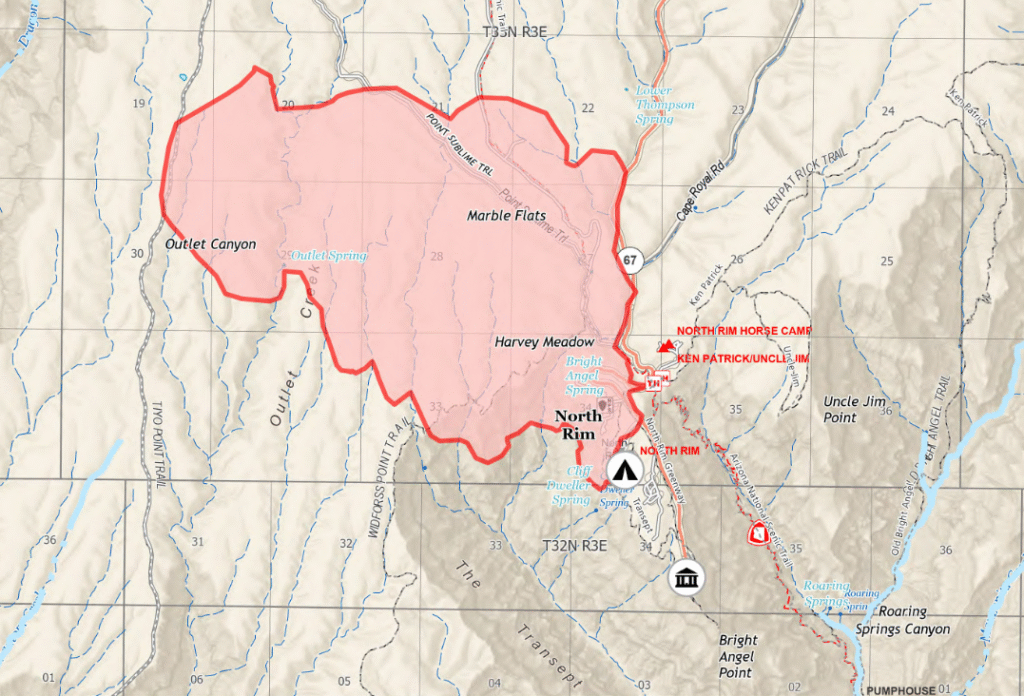Federal wildfire response under scrutiny after iconic North Rim lodge burns; closures and health risks grow amid Arizona’s extreme heat and chaos.
A National Treasure Lost in Flames
The Grand Canyon Lodge, an iconic structure standing on the North Rim since 1937, was reduced to rubble on the night of July 12, 2025, as the fast-moving Dragon Bravo Fire tore through the northern sector of Grand Canyon National Park. Fanned by 40 mph wind gusts and fueled by parched summer vegetation, the fire expanded rapidly—consuming between 50 to 80 structures, including historic cabins and critical administrative facilities.
For many Americans, the Grand Canyon Lodge was more than just a hotel. It was a piece of living history, a serene perch for watching the canyon glow under golden sunsets, and a launchpad for countless adventures. Now, it stands as a symbol of what may be an era of growing wildfire devastation fueled by climate extremes.

What Caused the Dragon Bravo Fire?
The blaze was first ignited on July 4, 2025, reportedly by a lightning strike in the Kaibab Plateau. Initially, the fire was being “managed” under a controlled burn strategy, a controversial tactic designed to reduce long-term fire risk. However, extreme heat, low humidity, and shifting winds turned what was a monitored burn into an out-of-control inferno.
Arizona Governor Katie Hobbs took to X (formerly Twitter), calling for a full federal investigation into the incident. She questioned why such a strategy was pursued during one of the hottest periods of the year. With over 5,000 acres scorched and critical infrastructure destroyed, questions about accountability are growing louder.
A Toxic Turn: Chlorine Gas Leak Raises Health Alarms
As the fire reached the North Rim Water Treatment Facility, an unexpected and alarming development occurred: the release of chlorine gas. Chlorine, being heavier than air, began settling into the inner canyon, prompting the immediate evacuation of all firefighters and hikers in nearby areas, including Phantom Ranch and popular trails such as the North and South Kaibab.
River rafters were instructed to bypass the affected areas, and all backcountry activities were suspended until further notice. While NOAA’s HYSPLIT model currently suggests no critical risk to nearby communities like Lees Ferry and Marble Canyon, many residents have reported a distinct chlorine smell—raising public concern.

Complete Shutdown of the North Rim
For the first time in recent memory, the entire North Rim of the Grand Canyon National Park is closed for the remainder of the 2025 season. All associated campgrounds, trails, and even ranger stations are under evacuation orders or protective shutdowns.
Closed areas include:
- North Kaibab Trail
- South Kaibab Trail
- Phantom Ranch
- Bright Angel Trail below Havasupai Gardens
Extreme heat warnings—up to 115°F (46°C) in the canyon floor—further complicate firefighting efforts and visitor safety.
Firefighters Face Brutal Conditions
On the night of July 12, fire crews undertook a heroic operation under life-threatening conditions. Battling erratic winds and smoke plumes, they attempted aerial bucket drops and dug defensive lines to slow the fire’s advance. However, due to the chlorine gas hazard, use of retardant aircraft was suspended.
According to the Grand Canyon Office of Communications, no fatalities or injuries have been reported, a credit to swift evacuation procedures and well-coordinated fire crew strategies. Still, over 500 visitors and 100+ staff were displaced.
How Big Is the Dragon Bravo Fire?
The latest estimates from Inciweb, the federal wildfire tracking system, show that the Dragon Bravo Fire has burned over 5,000 acres, with containment still near zero. The blaze continues to exhibit “extreme behavior” and is now classified as a high-priority wildfire within Arizona’s increasingly volatile fire season.
Compounding the situation is the nearby White Sage Fire, which has consumed 40,200 acres with 0% containment as of July 13. This fire, sparked by a thunderstorm, is threatening to converge with the Dragon Bravo Fire, presenting further risk to regional infrastructure and ecosystems.

What Does This Mean for Visitors and Local Economies?
The closure of the North Rim and cancellation of all bookings at the Grand Canyon Lodge are expected to have a severe financial impact on local businesses like the Jacob Lake Inn, which had to evacuate 75 employees and dozens of guests. Many tourists had to abandon long-awaited vacations.
“I feel terrible for the people who came to see the canyon for the first time,” said Melinda Rich, owner of the Jacob Lake Inn. “It’s a hard financial hit, but safety comes first.”
Meanwhile, the South Rim remains open but is experiencing increased visitation pressure, which may lead to overcrowding and strain on services.
Also Read:
Federal Fire Response Under Scrutiny
Critics argue that federal agencies were too slow to respond decisively, especially given the area’s history of wildfire susceptibility. In 2020, flames came within 20 feet of North Rim cabins. Lessons from past near-misses, many argue, should have prevented this tragedy.
The call for a federal audit and independent investigation is now bipartisan. Conservation groups, local businesses, and Arizona’s state government all agree: the decisions made between July 4 and July 12 must be reviewed in detail.
The Role of Climate Change
This disaster also adds fuel (quite literally) to the debate around climate change and wildfire management. Rising temperatures, reduced snowpacks, and prolonged droughts have turned once-temperate highland forests into powder kegs.
2025’s fire season is shaping up to be one of the worst on record in Arizona, with early monsoon lightning exacerbating the danger. Experts say the Grand Canyon may become a bellwether for how climate change will impact national parks across the U.S. and beyond.

Can the Lodge Be Rebuilt?
The original Grand Canyon Lodge, built from native stone and timber in the 1930s, was a model of eco-sensitive architecture and a designated historic site. Rebuilding it will take years and millions of dollars—and it’s unclear whether a replica would carry the same cultural weight.
Still, park officials vow to restore what they can. “We owe it to future generations to preserve the spirit of this place,” said a Grand Canyon spokesperson.
What Happens Next?
As of now, firefighting efforts continue on all fronts. Additional aircraft and personnel have been deployed, and efforts are underway to reassess trail stability, gas levels, and public safety. The North Rim will remain closed indefinitely.
Visitors are advised to check NPS.gov for live alerts and avoid traveling to the North Rim or any affected backcountry zones. South Rim operations are functional but under pressure, and rangers urge visitors to plan ahead.
The destruction of the Grand Canyon Lodge is a tragedy with national significance. It highlights the real-world impact of extreme weather, poor disaster planning, and a growing tension between preservation and access.
As the 2025 wildfire season rages on, the Dragon Bravo Fire will likely be remembered not just for what it consumed — but for what it revealed about how vulnerable even our most sacred places have become.